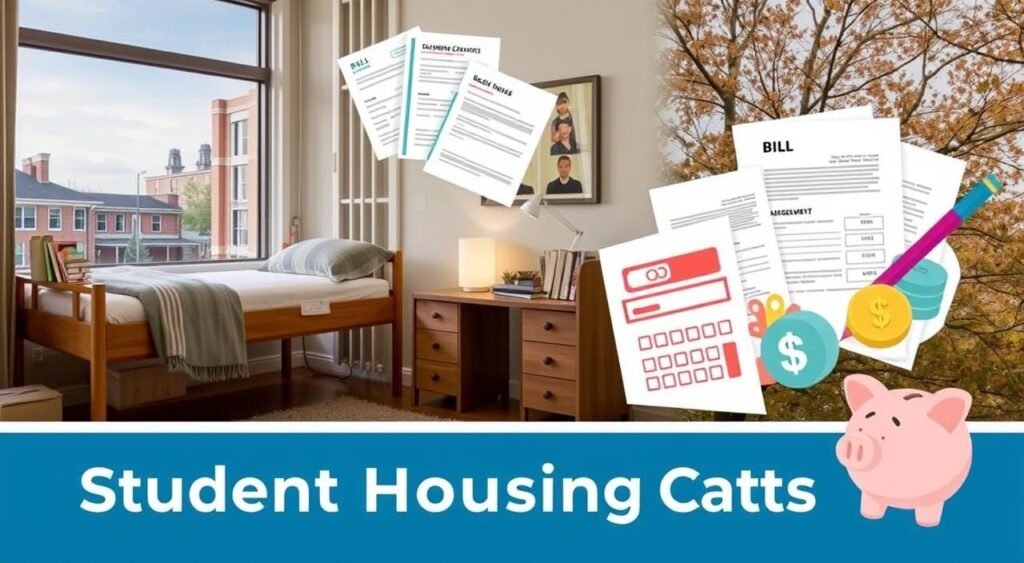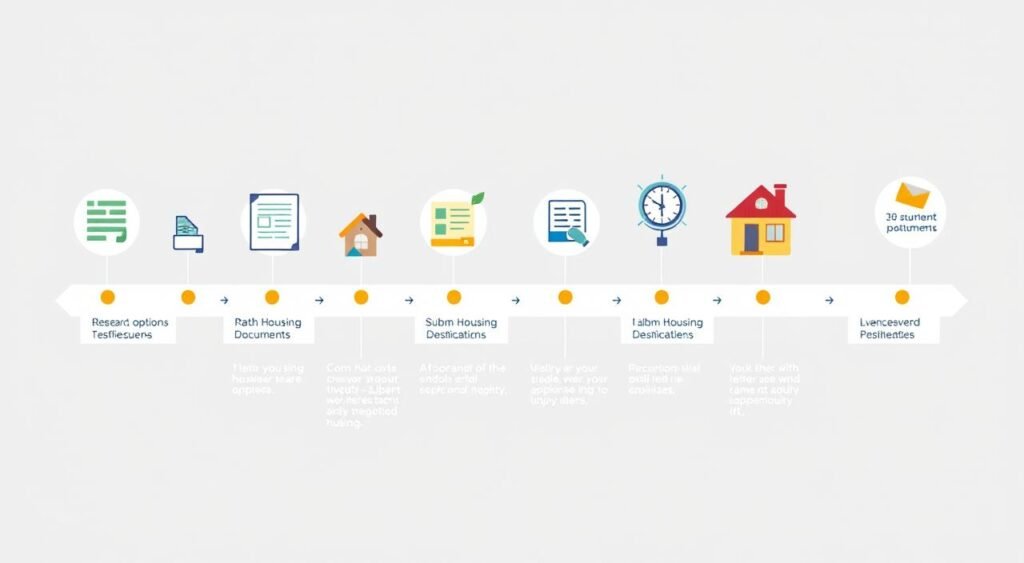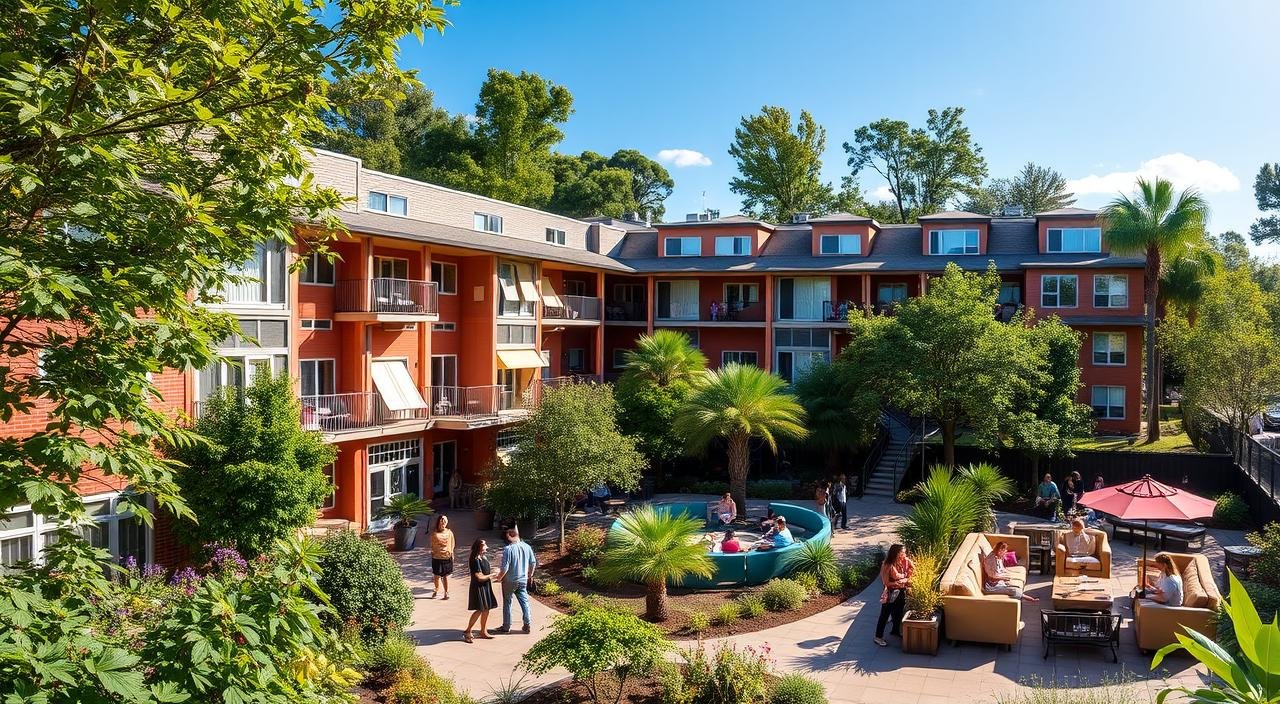Si eres estudiante internacional y quieres vivir en una residencias estudiantiles en los Estados Unidos, debes conocer ciertos requisitos. Hay diferentes tipos de visa para estudiantes, como la F-1 para estudios académicos, la M-1 para estudios vocacionales y la J-1 para visitantes de intercambio. Cada visa tiene sus propias reglas y limitaciones.
Para solicitar una residencia estudiantil, debes estar matriculado a tiempo completo en un programa educativo aprobado. También debes demostrar que sabes hablar inglés, tener dinero para vivir allí y no tener la intención de quedarte en los Estados Unidos. Estos son los pasos esenciales para obtener y mantener una residencia estudiantil en este país.
Principales Requisitos Clave
- Estar matriculado a tiempo completo en un programa educativo aprobado
- Demostrar dominio del idioma inglés
- Tener fondos suficientes para cubrir los gastos de estadía
- Mantener una residencia en el extranjero que no se tiene la intención de abandonar
- Cumplir con los requisitos específicos de la visa de estudiante (F-1, M-1 o J-1)
Understanding Student Residence Permit Types and Categories
International students face a complex world when studying abroad. They must understand different student residence permits. Each has its own rules and effects. Let’s look at the main types of student visas and what makes them special.
F-1 Student Visa Requirements
The F-1 visa is common for studying in the United States. It’s for those at accredited colleges, universities, or language schools. To get an F-1 visa, students must study full-time and keep up with their studies. They can work on campus and might get off-campus jobs after a year.
M-1 Student Visa Classifications
The M-1 visa is for vocational or non-academic programs, like technical schools. M-1 students can only do practical training after finishing their studies. This is different from F-1 students, who can work on campus and sometimes off campus.
J-1 Exchange Visitor Programs
The J-1 visa is for those in exchange visitor programs, like teaching, studying, or research. These programs are often backed by the U.S. government or approved groups. They offer chances for cultural exchange and learning.
It’s key for international estudiantes de tiempo completo to know about student residence permits in the United States. Understanding the F-1, M-1, and J-1 visas is the first step for a good educational experience.
Essential Documentation and Enrollment Requirements

Applying for a student residence requires specific documentación necesaria. This can change based on the school and visa type. You’ll usually need a valid passport, an acceptance letter from a SEVP-approved school, proof of financial support, and visa application forms.
Students must show they have ties to their home country and plan to return after studying. Some schools might ask for more, like academic transcripts, test scores, or health records. These are part of the certificado de matrícula process.
The carta de recomendación, or letter of recommendation, is important. It shows the applicant’s academic and personal qualities. An entrevista personal, or personal interview, might also be needed. This helps evaluate the applicant’s fit for the program.
Having all the right documents and meeting enrollment requirements is key. It’s important to show you’re enrolled full-time and comply with visa rules.
| Document | Description |
|---|---|
| Valid Passport | Provides proof of identity and citizenship |
| Acceptance Letter | Confirms admission to a SEVP-approved school |
| Proof of Financial Support | Demonstrates ability to cover educational and living expenses |
| Visa Application Forms | Completed forms required for visa application process |
| Academic Transcripts | Provides evidence of academic qualifications and achievements |
| Standardized Test Scores | Demonstrates academic aptitude and English proficiency |
| Health Records | Ensures compliance with medical requirements for enrollment |
| Letter of Recommendation | Provides insight into the applicant’s abilities and character |
| Personal Interview | Allows for further evaluation of the applicant’s qualifications |
By preparing and submitting the right documentación necesaria, students can boost their chances. They’ll be more likely to get a student residence permit and start their studies.
Academic Institution Registration and Verification Process

Getting a student residence permit can be tricky. You need to go through the academic institution registration and verification process. Schools must be approved by the Student and Exchange Visitor Program (SEVP) to accept international students. They issue the Form I-20, which is needed for a student visa.
University Enrollment Verification
To keep your student status, you must do well in school and be enrolled full-time. This is key to the residency permit process. It shows you’re really studying.
Academic Performance Standards
Academic performance is also watched closely. You need to meet your school’s academic standards to keep your permit. Not meeting these standards could risk your permit.
Institution-Specific Agreements
Some student homes have deals with certain schools. This might limit who can live there, as it’s tied to the school. Knowing about these agreements is important when looking for student housing.
| Key Requirements | Details |
|---|---|
| SEVP Approval | Educational institutions must be SEVP-certified to accept international students and issue Form I-20. |
| Enrollment Verification | Students must maintain satisfactory academic progress and full-time enrollment at their SEVP-approved school. |
| Academic Performance | Students must meet the institution’s specified academic requirements to retain their residency status. |
| Institutional Agreements | Some student residences may have agreements with specific universities, potentially limiting access for students from other institutions. |
The process of getting and keeping a student residence permit is important. You must follow SEVP rules, keep up with school, meet academic standards, and know about school agreements. All these steps are key to the process.
Financial Requirements and Cost Considerations

Prospective students need to show they can pay for their education and living costs. They must provide proof of funds for tuition, living expenses, and other costs. This can include bank statements, scholarship letters, or sponsorship documents.
The cost of living varies by location, institution, and housing type. Students also face expenses like health insurance and textbooks. But, some residences offer financial aid or help those with lower incomes.
| Expense Category | Estimated Cost Range |
|---|---|
| Costos de residencia | $8,000 – $15,000 per academic year |
| Gastos de manutención | $5,000 – $12,000 per academic year |
| Presupuesto estudiantil | $15,000 – $30,000 per academic year |
Students should look into ayuda financiera like scholarships and grants. These can help lower the cost of living and make studying more affordable.
«Securing a student residence is not just about finding a place to live, but also about managing the financial requirements and costs associated with it. By understanding the diverse range of expenses and exploring available financial aid options, students can make informed decisions and ensure a more seamless transition into their academic journey.»
Residencias Estudiantiles Application Timeline and Deadlines

Applying for student housing is a key part of joining a university. The application deadlines vary a lot between schools. Many colleges start accepting applications months before the new school year starts. This makes the selection process very competitive.
It’s wise to apply early because there’s a lot of demand for on-campus housing. Some schools have special deadlines for certain students or types of housing. They might look at your grades, financial situation, or how diverse you are.
Submission Periods
When you can apply for student housing varies. It could be just one deadline or several times during the year. Knowing the exact deadlines for your school is very important. It can really help you get into the housing you want.
Priority Application Windows
- Colleges often have special application times for certain students, like first-year or transfer students.
- Meeting these early deadlines can give you an edge in getting housing. It’s key to know and meet these deadlines if you can.
- If you miss the priority deadline, you might get lower priority in the housing selection. This could affect your chances.
| Institution | Application Deadline | Priority Window |
|---|---|---|
| Whittier College | March 1 | Early Action: November 1 |
| California State University, Northridge | April 15 | Incoming Freshmen: February 1 |
Knowing the deadlines and how the selection works is key for a smooth application. Applying early in the priority windows can boost your chances of getting into your preferred housing.
Length of Stay and Housing Arrangements
When you study abroad, how long you stay and where you live are key. Student residences offer flexible choices to meet international students’ needs.
Your stay’s length usually matches your academic program’s duration. F-1 visas let you stay for your studies’ full length. M-1 visas have a set time limit. Knowing your visa’s rules is vital for a smooth stay.
International students can live in dorms or private apartments. Some places offer year-long contracts, while others have shorter stays. Think about location, amenities, and community when choosing where to live.
| Housing Option | Average Monthly Cost | Typical Amenities |
|---|---|---|
| Host Family | $250,000 CLP | Meals, Cultural Immersion |
| Shared Apartment | $380,000 CLP | Shared Living Spaces, Kitchenette |
| Student Residence | Varies | Dorm-Style Rooms, Shared Facilities |
| Private Room | Varies | Independent Living, Flexible Arrangements |
Think carefully about your duración de la estancia and tipos de alojamiento. This choice affects your studies, budget, and personal life. Your contratos de residencia and opciones de vivienda shape your study abroad journey.
Also Read: What Types Of PhD Scholarships In USA Are Available?
Conclusion
Getting a student residence in the United States is a big task. It involves visa rules, school enrollment, money planning, and finding a place to live. International students should start early and do their homework. They should also ask for help from their school’s international office.
It’s important to know about different visas like F-1, M-1, and J-1. You need to meet each visa’s needs. You must also fill out the right forms, show you’re enrolled in school, and prove you have enough money.
Looking into where to live is also crucial. You can choose from school dorms or other living spaces. This helps you find the perfect place for your experiencia estudiantil.
By tackling these steps, international students can better adapt to the culture. They can also get the most out of recursos para estudiantes internacionales. This makes their academic journey rewarding and enriching.
FAQs
Q: ¿Qué requisitos se necesitan para solicitar una residencia estudiantil?
A: Los requisitos pueden variar dependiendo de la residencia, pero generalmente necesitarás ser estudiante, presentar documentos de identificación, y en algunos casos, un comprobante de matrícula en una universidad.
Q: ¿Dónde se encuentran las mejores residencias universitarias en Barcelona?
A: Barcelona cuenta con una gran variedad de residencias universitarias para estudiantes, muchas de las cuales están ubicadas cerca del centro de la ciudad y ofrecen fácil acceso al transporte público.
Q: ¿Qué tipo de habitaciones se pueden encontrar en las residencias de estudiantes?
A: En las residencias de estudiantes puedes encontrar habitaciones individuales, compartidas, y suites, dependiendo de la residencia y de las preferencias de los estudiantes.
Q: ¿Qué experiencia se puede esperar al vivir en una residencia estudiantil?
A: La experiencia de vivir en una residencia estudiantil se caracteriza por un ambiente social activo, oportunidades para hacer amigos, y una variedad de actividades organizadas para los estudiantes.
Q: ¿Es necesario tener una experiencia previa para vivir en una residencia universitaria?
A: No es necesario tener experiencia previa, ya que las residencias están diseñadas para ayudar a los nuevos estudiantes a adaptarse a la vida universitaria y ofrecer un lugar donde se sientan como en casa.
Q: ¿Qué servicios suelen ofrecer las residencias universitarias en Barcelona?
A: Las residencias suelen ofrecer servicios como conexión a internet, limpieza, áreas comunes, y actividades recreativas para que los estudiantes disfruten de su vida en la residencia.
Q: ¿Cómo puedo aplicar a una residencia estudiantil en Barcelona?
A: Puedes aplicar a través de la página web de la residencia de tu elección, donde encontrarás un formulario de solicitud y la información necesaria sobre el proceso de admisión.
Q: ¿Las residencias universitarias para estudiantes en Barcelona son costosas?
A: Los precios varían según la ubicación y los servicios ofrecidos, pero hay opciones para diferentes presupuestos, por lo que puedes encontrar una residencia que se ajuste a tu situación económica.
Q: ¿Qué beneficios ofrece vivir en una residencia cerca de la universidad?
A: Vivir en una residencia cerca de la universidad te permite disfrutar de un acceso fácil al campus, contribuye a mejorar tu experiencia académica y facilita la socialización con otros estudiantes.
Source Links
- https://heymati.com/blog/residencia-estudiantil-requisitos-acceso/
- https://www.vidaestudiantil.una.ac.cr/residencias
- https://www.studying-in-germany.org/german-student-visa/
- https://oead.at/en/to-austria/entry-and-residence/residence-permit-student-mobility-programme
- https://fam.state.gov/fam/09FAM/09FAM040205.html
- http://www.idra.org/wp-content/uploads/2017/08/eBook-Immigrant-Students’-Rights-to-Attend-Public-Schools-2017-August.pdf
- https://www.americanaschool.org/registration/required-documentation/new-student
- https://www.mamkschools.org/parent/registration/registration-process
- https://gulfstreamelementary.net/wp-content/uploads/2020/07/Student-Registration-Guide-for-Parents-Legal-Guardians-English-Spanish-Haitian-Creole.pdf
- https://www.king.edu/la-vida-de-residencia-preguntas-comunes/
- https://www.bookingninjas.com/blog/what-is-the-demand-for-student-housing
- https://www.mvc.edu/consumer-guide
- https://www.eduespa.org/english/wp-content/uploads/2021/01/Economic-Impact-of-International-Students-in-SPAIN-2020.pdf
- https://www.whittier.edu/reslife/faq/preguntas
- https://w2.csun.edu/housing
- https://suabroad.syr.edu/madrid/wp-content/uploads/sites/2/2024/06/Residence-Hall-Guidelines-Fall-2024.pdf
- http://nexointernacional.fen.uchile.cl/wp-content/uploads/2023/12/guia2023_dic1.pdf
- http://nexointernacional.fen.uchile.cl/wp-content/uploads/2021/11/FEN_Health_and_Housing_Guide.pdf
- https://covive.mx/en/2024/02/residencias-universitarias-vs-coliving-en-monterrey-cual-es-la-mejor-opcion-para-estudiantes/
- http://scielo.sld.cu/scielo.php?script=sci_arttext&pid=S0257-43142017000200016



